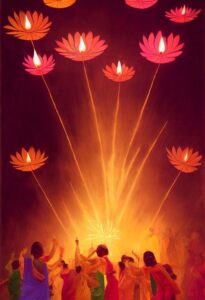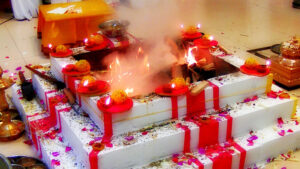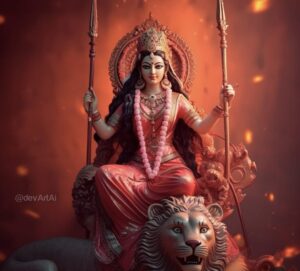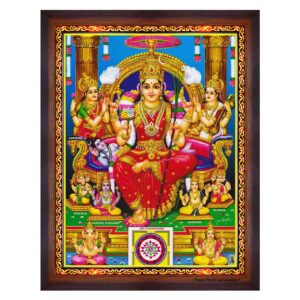Raja Rajeshwari, also known as Rajarajeshwari or Laitha Tripura Sundari, is a form of the Divine Mother or Devi in Hinduism. She is revered as the ultimate goddess of the Sri Chakra, a sacred geometric diagram used in the worship of the Divine Mother.
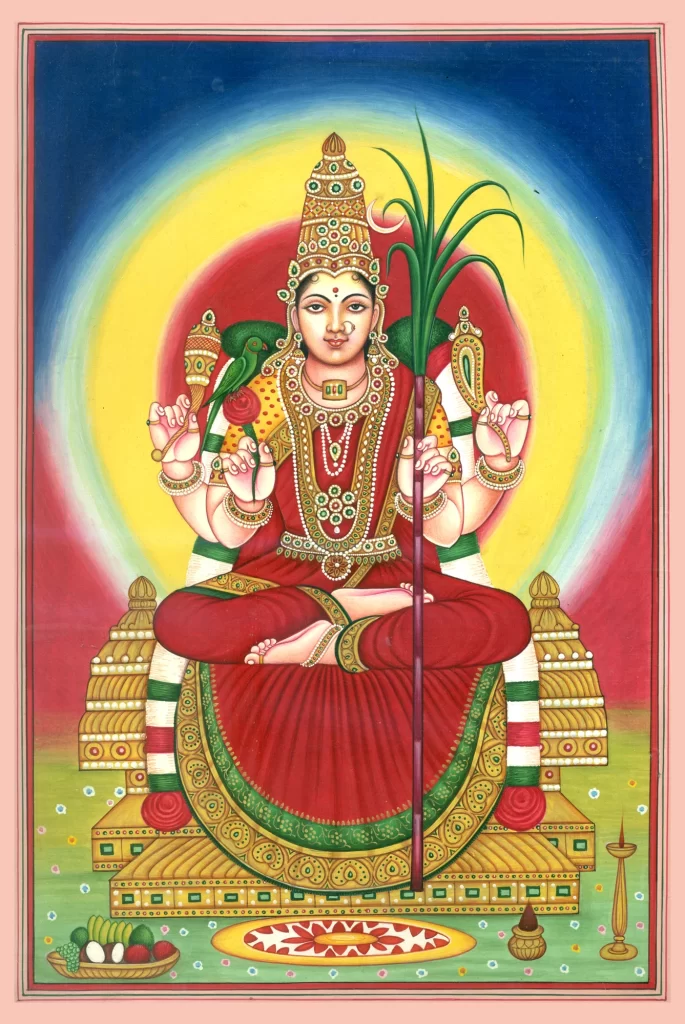
Other names of Raja Rajeshwari devi are Sri Vidya, Lalitha Parameswari, Maha Tripurasundari, Shodashi, Kamakshi,etc. Devi Raja Rajeshwari not only gives birth to the universe but also governs the entire cycle of creation, preservation and destruction. In essence, she is the divine force that encompasses the roles of Brahma, Vishnu and Shiva combined. Consequently, all gods pay unwavering reverence to the omnipotent Goddess.
The Trimurthis, who are Brahma, Vishnu and Maheswara, are the divine rulers of Ashta Digpalakas, known as Rajeswar. Rajarajeswari is the goddess who reigns supreme over these Trimurthis.This symbolizes her omnipresence and supreme nature, as she is the ultimate source and culmination of all divine energies and deities.
Her name “Raja Rajeshwari” translates to “the Queen of Queens,” signifying her supreme and regal status among deities. Raja Rajeshwari embodies the concept of supreme femininity, representing both beauty and power.
Emergence of Raja Rajeshwari Devi: According to Hindu mythology, Raja Rajeshwari Devi emerged as an embodiment of divine energy during a cosmic crisis. The universe was under threat from the demon Bhandasura, who had gained immense power and was causing chaos and suffering in the celestial realms. The gods and goddesses realized that they could not defeat Bhandasura alone and needed the help of a powerful divine force.
In response to the gods’ pleas, a radiant and awe-inspiring goddess manifested from the collective energy of all the supreme deities. This goddess was Raja Rajeshwari Devi, the Queen of Queens and the ultimate feminine power. She was adorned with exquisite beauty, multiple arms and divine weapons, signifying her authority and strength.
The Battle with Bhandasura: Raja Rajeshwari Devi, upon her emergence, waged a fierce battle against the demon Bhandasura and his formidable army. Her divine weapons and unparalleled prowess overwhelmed the demon, ultimately leading to his defeat. With her victory, she restored peace and balance to the universe.
Unveiling the Divine Play of Lalita
Within the sacred pages of the Brahmanda Purana, a thousand-year-old scripture originating from South India, unfolds a mystical tale that reveals the profound inner significance of Lalita’s divine play with her devotees. Lalita, whose name means “she who plays,” is a goddess of unparalleled beauty and grace. Her story, encapsulated in the section known as “The Glory of Lalita,” holds profound wisdom.
In this tale, Shiva, the lord of the universe, is deeply immersed in ascetic practices, engrossed in profound meditation. However, his contemplation is suddenly disrupted by a surge of lust. While two of his eyes remain serenely closed in meditation, his third eye reluctantly opens, seeking the source of the disturbance. To his astonishment, he finds Kama, the mischievous god of love, grinning playfully, having just released an arrow of desire. In response, a laser-like bolt emanates from Shiva’s awakened eye, reducing Kama to ashes. The third eye calmly closes and Shiva resumes his meditation.
Yet, from the ashes of love, a formidable demon named Bhanda arises, ablaze with an insatiable craving for power, wealth, and sensual indulgence. Bhanda possesses a unique and perilous ability: whenever he wages war on an adversary, half of the opponent’s strength is instantaneously transferred to Bhanda. As a result, Bhanda rapidly ascends to become a formidable king, relentlessly expanding his dominion.
Observing the escalating threat posed by Bhanda, the sage Narada appears before the gods, urging them to seek the aid of the Divine Mother Lalita. He emphasizes that only Lalita can assist them in thwarting this menacing adversary, thereby preserving cosmic harmony and order.
Depiction: Raja Rajeshwari is typically depicted as a radiant and resplendent goddess. She is often portrayed seated on a lotus throne within the Sri Chakra, an intricate symbol representing the universe. The goddess herself is shown with a benign expression, holding various weapons and symbols of divine power. She has four arms and is adorned with divine ornaments.
Attributes: Raja Rajeshwari is associated with numerous attributes and divine qualities, including:
- Supreme Power: Raja Rajeshwari is the embodiment of supreme divine power and represents the Shakti, or the feminine energy of the universe.
- Goddess of the Sri Chakra: She is the primary deity in the worship of the Sri Chakra, a sacred diagram used in the Sri Vidya tradition of Hinduism.
- Protector of Devotees: Raja Rajeshwari is believed to protect her devotees from various adversities and guide them on the path to spiritual awakening.
Worship of Raja Rajeshwari: The worship of Raja Rajeshwari is highly revered in the Sri Vidya tradition, a profound and esoteric branch of Tantric Hinduism. Devotees of Raja Rajeshwari engage in elaborate and intricate rituals, pujas (prayer ceremonies) and homas (fire ceremonies) to invoke and seek her divine blessings.
Worship of Raja Rajeshwari often involves the following practices:
- Sri Chakra Puja: Devotees meticulously perform the Sri Chakra puja, which includes the consecration of the Sri Chakra yantra, recitation of sacred mantras and the offering of various symbolic items to the goddess. Mother Raja Rajeshwari holds the highest position in the realm of the Sri Chakra, being the Supreme Goddess herself. She surpasses all other deities, as she is the source from which even Lord Brahma, the creator, emanates. The Sri Chakra is adorned with vibrant colors and intricate patterns that hold deep spiritual significance.
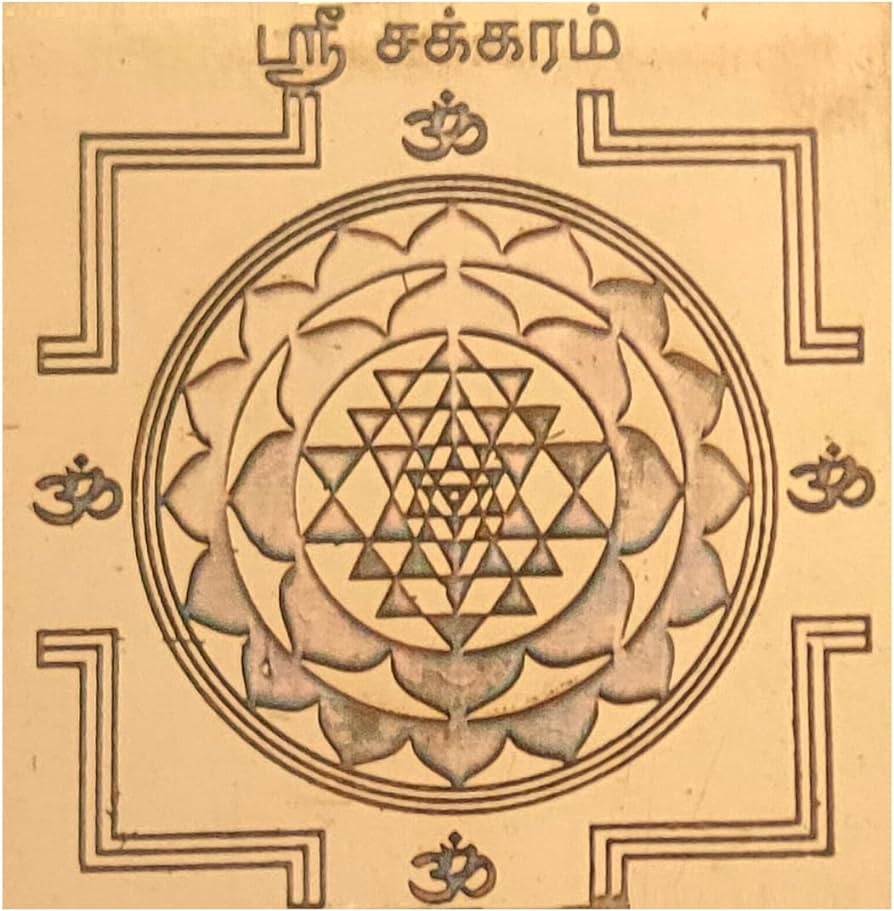
- Mantra Chanting: Chanting of specific mantras dedicated to Raja Rajeshwari is an essential part of the worship. These mantras are believed to invoke the goddess’s presence and blessings. Some of the prominent mantras include the Lalitha Sahasranama, Lalitha Trishati and Sri Lalitha Ashtottara Shatanamavali.
- Homam (Fire Ceremony): Homas, or fire ceremonies, are conducted to make offerings to the goddess through the sacred fire. Each offering is accompanied by the chanting of mantras, invoking the goddess’s grace. The homa is a transformative ritual, believed to purify the surroundings and the devotee’s mind and spirit.
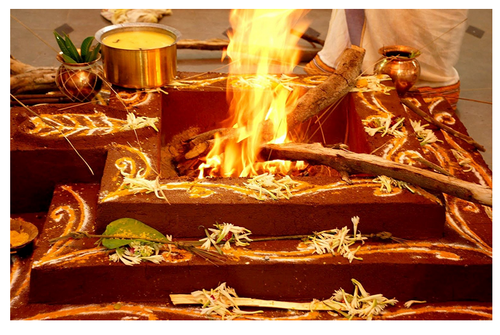
- Abhishekam: Devotees perform Abhishekam, the ritual of bathing the idol or yantra with various sacred substances such as milk, honey, ghee, and water, while chanting mantras. This act symbolizes the purification and sanctification of the goddess’s divine form.

- Meditation and Contemplation: Meditation on the Sri Chakra and visualization of the goddess’s form are essential practices in Raja Rajeshwari worship. Devotees focus their minds and hearts on the goddess, seeking to merge with her divine energy.
- Offerings: Offerings of fruits, flowers, incense and other auspicious items are made to the goddess as tokens of devotion and respect. These offerings are considered a way of showing gratitude to the goddess for her blessings.
Significance: The significance of Raja Rajeshwari lies in her representation of the ultimate divine feminine energy, which encompasses both beauty and supreme power. Her worship is a path to spiritual awakening and self-realization. Devotees believe that by connecting with Raja Rajeshwari, they can transcend the limitations of the material world and attain spiritual enlightenment.
Raja Rajeshwari’s worship emphasizes the harmony of feminine and masculine energies and the importance of devotion and surrender to the divine. She is considered the queen of queens, reigning as the supreme goddess and nurturing her devotees with love and protection.
The worship of Raja Rajeshwari is a profound spiritual journey that encourages devotees to seek the divine mother’s blessings for inner transformation, spiritual growth and the realization of their full potential. It is an integral part of the rich tapestry of Hindu spirituality and devotion.
Author,
Sivalenka Neeraja

